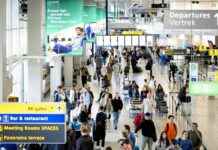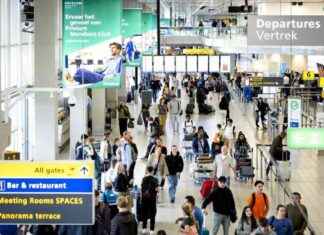life But here? No, thank you: more and more people find in Berlin a Job, leave their domicile but rather in another state. As an evaluation of the Federal employment Agency shows that an increase in the number of Berlin-commuters since 2013 on the 321 000 people. Most of the trips from the Region – from Brandenburg, to be exact. But also from more distant provinces the number of those who come to Berlin to Work increases. The highest growth rates among the commuters pay to Berlin (since 2013), University of Bremen, with a plus of 120 per cent, Baden-Württemberg, plus 109 percent, the Saarland, with 76 percent.
But the rush of commuters and leads to problems: congestion on the city highway in a congested subways under the earth, and to air pollution in the city centre, to name just three. We asked, therefore, in the case of experts, what needs to change so that Berlin can cope in the future, the commuter rush.
urban planners
In the first line of the commuter growth is a challenge for the Berlin infrastructure, and thus the development of the city. And since Jürgen Gies, one of the researchers as a research associate at the German Institute of urban Affairs (Difu) on the topic of mobility in Berlin “air up”. Because, as in all Metropolitan areas of frequent animals in the Berlin daily, a large number of commuters to the same places – and pushed to a transport infrastructure. Especially in the case of the transport relations with the surrounding Gies pent-up demand: “the reactivation of The Heather path must be for example: Compounds such as the Kremmener Bahn in the North or the Trunk line route in the South of the city must be operated to relieve the pressure on the transportation system.” At the same time, the reliability of the offers must be improved, he says. Much too often the trains came in and led trips to crowded.
Gies’ colleague, Uta Bauer, who has been conducting research on the topic of urban and regional transport, to bear in mind that even within Berlin, a lot needs to be done to relieve the pressure on the infrastructure. “We take the relocation of Parts of individual transport on the bike that succeeds in many cities already,” she says. Also in Berlin, projects in development, which could facilitate the intra-urban Commuting in the future, with the Senate scheduled radschnellwegen infrastructure.
where do the commuters come from.Graphics: Tsp/Böttcher
But also the economy of transport have not increased lately, what relationships last with the Boom in online trading. “In the long term, it would be important, therefore, that to build neighborhood-based distribution centers, with which the economy of transport by logistics companies such as DHL or UPS, better bundle up.” Of such Mikrohubs from the delivery would be on the last meters to the customer better on smaller electric vehicles or bike Transporter to distribute, which in turn would relieve the roads. “This works currently very well and could, in the medium term to further expand it,” says Bauer.
“it is now Important to create, in the planning of new development areas currently being produced in large numbers, offers, which make private Car use largely superfluous. This can be done in the Form of a good connection to the public TRANSPORT network or by using alternatives such as Car-Sharing services and bike rental systems.“ One thing is clear, says Gies: “planning errors, such as the lack of a local connection, such as in the märkisches Viertel are not likely to repeat itself in the future.”
But, while Gies, the public transport offer to extend, he pleads, at the same time, to make it difficult for motorised individual transport. “For So long, many employers identify areas in the city is still a great Park, as long as it remains attractive to drive your own car in the city,” he says. The need to control the traffic planning of the city is still much stronger. A medium could be, the car Park management to extend and thus driving a car more expensive in the city.
health experts
Not only for roads, bridges and S-Bahn-lines of the daily onslaught of the Problem, but also for the commuters. Because the time on the road can make you sick – the studies show for many years. “Can’t generalize it, but there are health complaints associated with the Commute,” says Anne Marit Wöhrmann, a research associate of the Federal Institute for occupational safety and health (BAuA). The spectrum of diseases is large: “Many commuters complain of sleep disorders, because anyone who travels a lot, has less time to recover,” says Wöhrmann. At the same time, the spherical stress, irritability and exhaustion cause: “those Who are in crowded trains with no seat, or on the cold train platform for the feet is in the belly or in a traffic jam, stuck, will not arrive in a good mood at home.”
Some suggest the travel stress even on the stomach, warns the psychologist: “the one Who commutes long, the fed might be unhealthy or inconvenient times,” which, in turn, can lead to stomach discomfort and digestive disorders. The Severity of the health consequences is, ultimately, depending on how commuters make their travel time and how long you are on the go. A total of 20 000 workers surveyed Wöhrmanns authority, in accordance with your pendulum rituals. Result: About half of the commuters took the easy route to the workplace 15 minutes a day. A third of the study participants was a day between 30 minutes and an hour on the road. And one in every six Respondents was even more than an hour every day on the road. According to the study, Employees are with their Work-Life Balance all the more dissatisfied, the more time the daily Commute. With a longer transit time is also different health complaints.
However, not only the length of the route travelled, but also the predictability of the daily Commute, the well-being of workers strongly influence. “If I can rely on the fact that my journey time takes 20 minutes, charged me the Commute is less than, for example, a Situation in which I must always fear, that buses or trains are late and I miss the connection,” says Wöhrman.
but What to do? “The best way to prevent health consequences is to reduce the commuting time – for example, by a relocation or a second home in the vicinity of the place of Work,” says Wöhrmann. “For a week, commuters are less tired and exhausted than employees who have to travel every day long distances. However, the prolonged separation from family and friends can be stressful.“
But also to stay for commuters, do not want to go this step or can, ways to make your commute more bearable. It is important that you try to use the commuting time is positive. “If you listen to an audiobook or vocabulary for the Spanish course to master the study of, not as quickly the feeling to waste time on the train,” says Wöhrmann.
However, not only the employee, the supervisor can contribute to the workforce appears more rested at work. “If the employer sliding offering time, this is a lot of value, because I get no Stress, when I stand in a traffic jam and a few minutes later was at work.”
working time-consultant
And that there are a lot of flexible working time models, no one knows better than Andreas Hoff. More than 30 years, Hoff co-founded the first German working time, advice and debate for more flexibility since followed. “The mechanical work of the time – however, with a defined core working hours – is a German invention from the late 60s, which was already introduced at that time, with the thought in mind to prevent traffic jams.” The model has been extended in the following decades, and in many places, welded to the core walls by now times, and would be replaced by service times, while the would have the employees accessible, but not present in the office. “For the customers, it is usually no matter whether you catch the staff in the office or in the private apartment,” says Hoff.
“I do recommend the companies that the workplace remains, of course, already in operation,” says Hoff. But often, when employees do prior to the trip to the office or other professional task at home. “Why should I not take that as an employer, regardless of the drive of my staff and give them the opportunity to avoid the peak hours?”
But not only several hours, a lot of companies to confess to their employees, in the meantime, all working days away from the operation: “From my experience, the willingness to allow employees to take Home Office days is with large enterprises, across the Board.” More still, those who do not offer such working time models, have now even problems to recruit good staff. It is a different matter, however, when it comes to Jobs beyond the big companies: “Smaller firms are still hanging on to the core working hours and have a hard time with really flexible working-time models and Home Office days,” says Hoff. “But of course, you also come under increasing pressure.”
More about
transport in the greater Berlin area Berlin car drivers, a traffic jam is summer can order before
Klaus Kurpjuweit, Christian Hönicke
Twelve of the Newsletter, twelve districts: Our people-the Newsletter from all districts of Berlin it here for free: leute.tagesspiegel.de








